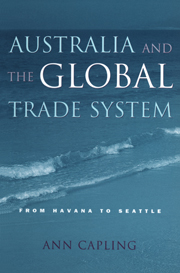Book contents
- Frontmatter
- Contents
- List of Tables and Figures
- Acknowledgments
- List of Abbreviations
- Introduction
- 1 ‘The Enfant Terrible’: Australia and the Reconstruction of the Multilateral Trade System
- 2 Coming to Terms with Multilateralism
- 3 Damage Control, Policy Stasis and Diplomatic Paralysis
- 4 Policy Innovation, Diplomatic Departures and the Uruguay Round
- 5 The Cairns Group
- 6 Aggressive Multilateralism: Negotiating Services
- 7 The American Way? Aggressive Bilateralism in Australian Trade Policy
- 8 The WTO System in Crisis
- Conclusion
- Appendix 1 Departments and Ministers responsible for GATT/WTO Negotiations
- Appendix 2 GATT Trade Runds
- Notes
- Index
7 - The American Way? Aggressive Bilateralism in Australian Trade Policy
Published online by Cambridge University Press: 07 October 2011
- Frontmatter
- Contents
- List of Tables and Figures
- Acknowledgments
- List of Abbreviations
- Introduction
- 1 ‘The Enfant Terrible’: Australia and the Reconstruction of the Multilateral Trade System
- 2 Coming to Terms with Multilateralism
- 3 Damage Control, Policy Stasis and Diplomatic Paralysis
- 4 Policy Innovation, Diplomatic Departures and the Uruguay Round
- 5 The Cairns Group
- 6 Aggressive Multilateralism: Negotiating Services
- 7 The American Way? Aggressive Bilateralism in Australian Trade Policy
- 8 The WTO System in Crisis
- Conclusion
- Appendix 1 Departments and Ministers responsible for GATT/WTO Negotiations
- Appendix 2 GATT Trade Runds
- Notes
- Index
Summary
During the 1980s and early 1990s there was broad bipartisan support for the three pillars of Labor's trade policy: unilateral trade liberalisation, open regionalism and multilateralism. In the lead-up to the 1996 federal election, however, this consensus began to break down as the opposition Liberal and National parties sought to distance themselves from the Labor government and place their own distinctive stamp on trade policy. Hoping to capitalise on voter discontent with Labor's regionalist and internationalist inclinations, under John Howard's leadership the coalition promised a more vigorous and results-oriented approach to Australian trade policy, with emphasis on bilateral efforts to open export markets for Australian producers.
Initially it seemed that this bilateralist turn in coalition policy was little more than an exercise in product differentiation for campaign purposes. After all, Australia has dozens of bilateral economic agreements and lobbies constantly on a country-to-country basis on a wide variety of economic, trade, investment and taxation issues. In that sense, promoting ‘bilateralism’ was simply a means of bringing to the fore an aspect of Australian trade policy that tended to be crowded out by Labor's emphasis on regional and multilateral trade issues. Once in power, however, it became evident that the Howard government's pledge to ‘get tough’ on trade signalled the beginning of a new phase in Australian trade policy.
Aggressive Bilateralism
The coalition's election commitment to bilateralism was reaffirmed in the 1997 White Paper on Foreign and Trade Policy which described bilateral relationships as the ‘basic building block’ of Australia's trade and foreign policies.
- Type
- Chapter
- Information
- Australia and the Global Trade SystemFrom Havana to Seattle, pp. 171 - 190Publisher: Cambridge University PressPrint publication year: 2001



